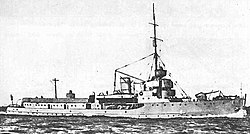Zieten (ship, 1919)
|
Nettelbeck
|
||||||||||||||||||||
|
||||||||||||||||||||
|
||||||||||||||||||||
|
||||||||||||||||||||
|
||||||||||||||||||||
The Zieten was a ship that was built by the German Imperial Navy as a minesweeper , used by the Reichsmarine as a fishery protection ship and by the Kriegsmarine as a clearing boat escort , and in 1945 it ended as a minesweeper in the Baltic Sea . The ship was initially called M 138 , then Zieten , then Nettelbeck and finally M 538 .
Construction and technical data
The ship, a minesweeper class minesweeper 1916 , was built at the Joh. C. Tecklenborg shipyard in Geestemünde ( Bremerhaven ) for the Imperial Navy and was given the number M 138 . Construction began in 1918, but the ship was not completed until the end of the war in November 1918. Since its construction was already very advanced, however, it was allowed to be completed. The launch took place on February 17, 1919 and the commissioning on March 20, 1919.
The ship was 59.60 m long and 7.40 m wide and had a draft of 2.15 m . The water displacement was 508 tons (standard) and 548 tons (maximum). Two 3-cylinder triple expansion steam engines with a total of 1,850 hp gave the ship a speed of 16 knots over two screws . The bunker capacity of 115 t of coal allowed an action radius of 2000 nm at a cruising speed of 14 kn. The armament consisted of two 8.8 cm L / 30 guns. In addition, the ship could carry up to 30 mines .
Imperial Navy
In the Reichsmarine, the ship, renamed Zieten on September 1, 1921 , initially served as a tender with the commander in charge of securing the North Sea. However, since the Reichsmarine urgently needed a ship for fisheries protection, they had the ship converted into a fishery protection ship in 1923/24, and on September 11, 1924 the Zieten began its service as such. She thus succeeded the fishing protection cruiser SMS Zieten , which had provided this service before the First World War . The tasks ranged from the general protection of German fishing vessels and their fishing rights to medical and technical assistance to towing services for damaged or stranded fishing vessels and the prevention of illegal fishing in German territorial waters.
After the two specially built fishery protection ships Elbe and Weser began their service in 1932, Zieten was taken out of service on September 2, 1932 and assigned as a station tender to the North Sea naval station on October 4, 1932 .
Navy
With the upgrading of the Navy from 1935 and the establishment of mine clearance boat flotillas, it became necessary to add appropriately equipped escort ships to these flotillas, which served the boat crews as accommodation and the boats as fuel, ammunition, fresh water and food depot. After corresponding modifications, the Zieten was therefore used as a clearing boat escort from March 5, 1936. When the 1st clearing boat flotilla was set up in autumn 1937 (with the boats R 17 - R 24 ) in the Baltic Sea, the Zieten became the escort of this flotilla. In 1938/39 it was converted from coal to diesel firing at the Wilhelmshaven naval shipyard . After this conversion, the ship was named Nettelbeck on May 10, 1939 . The ship experienced the beginning of the war in the Baltic Sea, where the 1st clearing boat flotilla first carried out mine clearing service in the Bay of Danzig and then general security service. The flotilla then moved to the North Sea , and in April 1940 the Nettelbeck and her flotilla took part in the conquest of Horten during the occupation of Norway as part of "Warship Group 5" . Then the flotilla was used off the Dutch coast and in the English Channel .
On October 1, 1940, the ship was reclassified as a minesweeper again, armed with a 10.5 cm anti-aircraft gun and two 20 mm anti- aircraft guns and renamed the M 538 .
The End
The ship was sunk on June 21, 1944 in a Soviet air raid in Reval , but then lifted and towed to Königsberg for repairs. When the still not finished ship on January 16, 1945 by M 801 by Gotenhafen (Gdingen) was dragged, pulled in a storm, the tow and the vessel was at 54 ° 38 '6 " N , 18 ° 48' 54" O of the beach of Hela thrown. On February 3, 1945 it was struck off the list of ships.
Notes and individual references
- ↑ One of their commanders at this time was the lieutenant captain and later rear admiral Siegfried H. Engel (September 28, 1927– September 24, 1929).
- ↑ M 566 then took over the function of command and escort ship for the 1st clearing boat flotilla.
- ↑ Source: http://www.balticwrecks.com/en/wrecks/nettelbeck/ .
Web links
literature
- Siegfried H. Engel: With the fishing protection boat "Zieten" to the fishing grounds of the North Sea and Iceland. ("Meereskunde" series, issue 195.) Ernst Siegfried Mittler & Sohn, Berlin, 1930.
- Erich Gröner : The German warships 1815-1945 . tape 1 . JF Lehmanns Verlag, Munich 1966, p. 301-307 .
